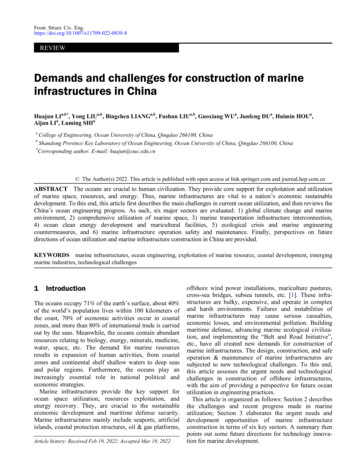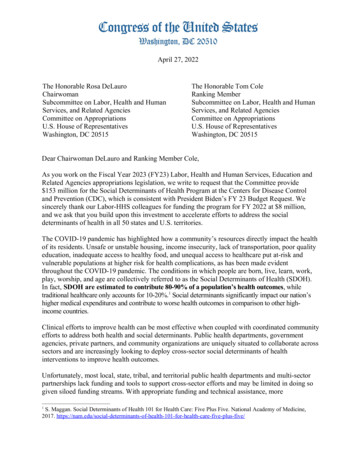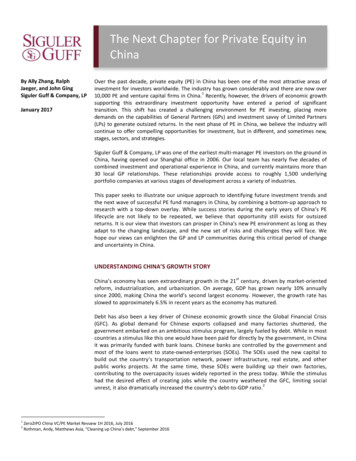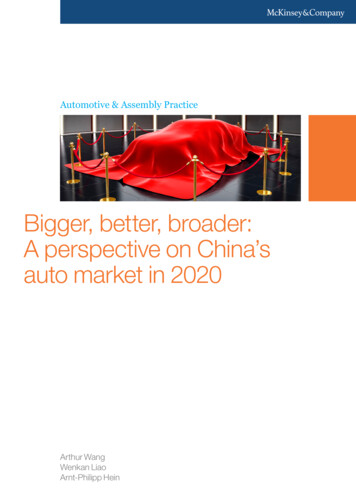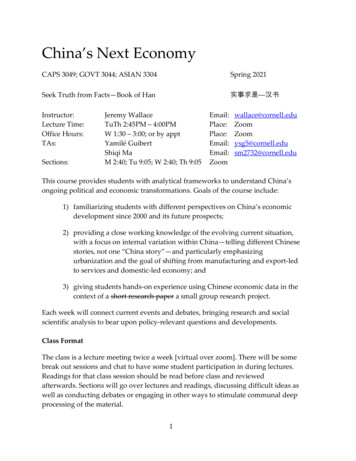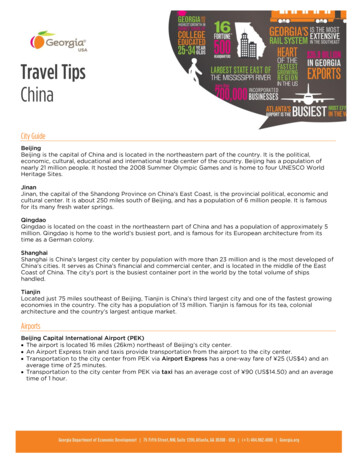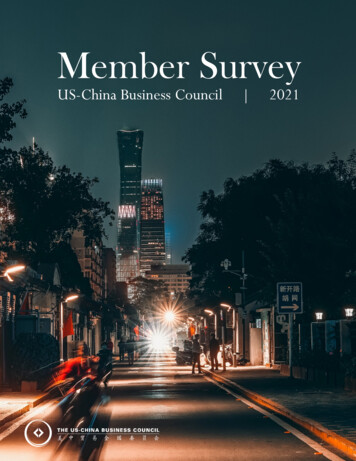
Transcription
Member SurveyUS-China Business CouncilUS-China Business Council0 20212021 Member Survey
Executive SummaryIn 2021, an overwhelming majority of USCBC member companies remain commercially successful inChina, a trend that has been well documented in USCBC’s annual member surveys for more than a decade.Nonetheless, companies still face significant challenges arising from US-China relations, the policy andregulatory environment, residual effects of the COVID-19 pandemic on travel, and rising costs.Four key themes emerged in this year’s survey:1. US-China tensions continue to weigh on American companiesConflicting pressures from both the United States and China threaten to put companies in anirreconcilable position, increasing uncertainty and geopolitical risk. For the fourth consecutiveyear, US-China relations rank as the top challenge for US companies doing business in China.Nearly half of respondents cite concerns about customers perceiving them as unreliable because ofUS-China tensions. Restrictions on travel between the countries—ranked third among this year’stop challenges—are exacerbating both political tensions and operational challenges.2. An uneven playing field is making it increasingly hard for US companies to competeState support for Chinese companies and regulatory barriers disproportionately affecting foreignbusinesses continue to skew the playing field, particularly as China becomes a more mature marketand competition intensifies. Challenges related to industrial policy, data and cybersecurity policy,intellectual property, and standards are exacerbated by bilateral tensions.3. The Chinese market remains critical to American companiesA majority of companies surveyed remain profitable, and more than 40 percent have plans toincrease resource commitments in China over the next year. The vast majority of respondentsinvest in China to serve the Chinese market, where they see strong growth prospects.4. Reduced optimism raises questions about US companies’ future prospects in ChinaGeopolitical and policy challenges are dampening optimism about China’s business environment,and US companies are now prioritizing China less than in years past. While most companies are notmoving their business or supply chains out of China, these challenges raise questions about theirfuture competitiveness in China, particularly if perception challenges intensify and the policyenvironment deteriorates further.US-China Business Council12021 Member Survey
Table of ContentsINTRODUCTIONUS-CHINA RELATIONSElevated US-China tensions are increasing risk and uncertaintyThe jury is still out on Phase One, but tariffs remain a major concernTravel restrictions are exacerbating operational and political challengesCHINESE POLICY ENVIRONMENTDomestic innovation policies are raising concern amid China’s push for technologicalself-sufficiencyProtectionist policies are skewing the playing fieldState support for Chinese companies is exacerbating competition concernsData flows and privacy rules are stoking widespread concernLongstanding intellectual property concerns persistAccess to standards setting remains challengingCOMPANY PERFORMANCE AND PLANNINGDespite challenges, a vast majority of companies remain profitable and continue togrowChina remains a very important market for US companiesChina remains a top priority, though less than beforeCompanies continue reporting that they are staying in ChinaMETHODOLOGY AND RESPONDENT PROFILEUS-China Business Council22021 Member Survey
IntroductionDespite a US presidential transition in 2021 and the beginnings of an economicrecovery in both the United States and China, tensions in the bilateral relationshiphave only intensified since USCBC published its last annual member survey report.US companies operating in China often find themselves in the crossfire, and thisyear’s survey reflects that reality.Over the last year, each country enacted policies—in the financial, trade,investment, and technology spheres—that run the risk of alienating the other fromits market. Over the same period, the pace of China’s economic reforms related tointellectual property and market access slowed, while state support for domesticfirms and restrictive data policies accelerated. These headwinds are compounded byuncertainty about the future of the US-China relationship, which is now impactingcompanies’ global strategies and investment plans.This report seeks to take stock of the current business environment in China, unpack the mostsignificant challenges faced by the US companies operating there, and explore the factorsshaping their business decisions.Top 10 Challenges1.2.3.4.5.6.7.8.9.10.US-China relationsCompetition with Chinese companiesInternational travel and visa restrictionsData flows and personal information rulesTariffsIntellectual property protectionExport controls and sanctionsLicenses and approvalsCOVID-19 impactsCost increasesUS-China Business Council32021 Member Survey
Elevated US-China tensions are increasing risk anduncertaintyTense US-China relations have had a detrimental impact on US companies doing business in China. USChina relations are the top challenge faced by survey respondents, as was the case for the past four years.The vast majority of those surveyed have been affected by bilateral trade tensions, with most characterizingthe impact as harmful or severely harmful to their businesses.Several other top challenges identified by companies are linked to friction in the US-China relationship,including tariffs, export controls, and sanctions. Bilateral tensions and subsequent policy efforts areimpacting Chinese perceptions about the reliability of US companies, as evidenced by the most commonlyreported impact of the trade tensions: lost sales due to customer uncertainty of continued supply.Impacts of US-China trade tensionsLost sales due to customer uncertainty ofcontinued supply48%Shifts in suppliers or sourcing due touncertainty of continued supply39%Impacts of nationalism in consumer decisions33%Increased scrutiny from regulators in China26%Lost sales due to tariffs that the United Statesimplemented26%Lost sales due to tariffs that Chinaimplemented22%Delay or cancellation of investment in theUnited States or China due to uncertaintyOtherUS-China Business Council18%19%Increased scrutiny from regulators in theUnited StatesExcluded from bids or tenders due to status asAmerican companyHave trade tensions impacted yourbusiness in China?18%Yes.No.15%12%482%2021 Member Survey
In response to a question asked for the first time thisyear, 45 percent of companies say they have feltpressure to make statements about political issues, andthat the pressure comes from both the US and Chinesegovernments as well as consumers. One-third ofrespondents say that nationalism has played a role inconsumer decisions as a result of US-China tensions.Has your company felt pressured to make(or not make) statements about sensitivepolitical issues in the US-China relationship?No.Yes, and this pressure has increased.Yes, but this pressure is no greater than inprevious years.While roughly a quarter of companies have not alteredtheir strategy due to the impacts of US-China tensions,many others have had to adapt. Some of theseadaptations include adopting a more localized approachto supply chains, production, services, and intellectualproperty while shifting away from certain industry orcustomer segments in China.10%55%35%Due to the impact of tensions, companies have altered their strategies by.Developing new supply chains for China-specific, US-specific, or other regionspecific businesses34%26%Not significantly altering their company’s strategyLocalizing more production, services, or IP in China than we normally wouldconsider in order to access local sales opportunities25%Shifting away from certain industry or customer segments in China25%16%Investing fewer resources in China10%Other9%Investing more resources in ChinaPursuing joint ventures with Chinese entities that we would not normallyconsider in order to access local sales opportunitiesUS-China Business Council6%52021 Member Survey
The jury is still out on Phase One, but tariffs remain amajor concernAs part of the Phase One trade agreement, China committed to making regulatory reforms and purchasingspecific and significant amounts of US goods and services over 2020 and 2021. China has made progress onits commitments but has not fully delivered on promised reforms or purchases. A plurality of respondentshave a neutral view of China’s implementation of the trade agreement, but a similar portion viewimplementation either somewhat positively or positively.Overall views on Phase One implementation so farPositive15%Somewhat positiveNeutral26%Somewhat negativeNegative45%11%3%Bilateral tariffs rank fifth among the top challenges faced by companies this year. Many had hoped that UStariffs—enacted following a Section 301 investigation into China’s trade practices—and Chinese retaliatorytariffs would be lifted upon signing the Phase One deal. However, a year and a half after the agreementwent into effect, steep tariffs on both sides remain in place. About half of respondents say it is still too soonto determine whether the costs of the tariffs are worth the benefits of Phase One, while another 41 percentbelieve that the tariffs are too costly, a camp that grew slightly since the last survey.Views on Section 301 actions52%56%7%7%36%41%20202021It’s too soon to say.The benefits of the trade agreement outweigh the costs of the tariffs.The costs of the tariffs outweigh the benefits of the trade agreement.US-China Business Council62021 Member Survey
Travel restrictions are exacerbating operational andpolitical challengesInternational travel and visa restrictions—a new option this year—are the third-largest challenge identifiedby companies in 2021. Due to China’s strict COVID-19 control measures, it remains extremely difficult toobtain visas to travel to China, even for critical business matters. Travelers that do manage to obtain a visaare required to endure long quarantines.How have travel restrictions impacted your operations in China?Cancelled international events/conferences in China57%Cancelled international executive exchangeprograms/training44%Delayed or cancelled significant business decisions sinceexecutives were not present29%Lost significant business opportunities becauseexecutives/personnel were not present23%Increased local hires13%The extreme difficulty in traveling between the United States and China has resulted in significantoperational challenges for US companies. Additionally, the absence of people-to-people exchanges haschallenged diplomatic relations, reducing the already narrow scope of engagements that are necessary toresolve and discuss sensitive political issues.US-China Business Council72021 Member Survey
Domestic innovation policies are raising concern amidChina’s push for technological self-sufficiencyMost respondents expressed some level of concernwith China’s policies promoting domestic innovationand manufacturing, and 39 percent of companies—aplurality—report that stronger government supportfor Chinese companies is linked to rising US-Chinatensions. Companies’ concerns are split fairly evenlybetween existing and potential impacts to business.What changes has your company observed inChinese industrial policies as a result of USChina trade frictions?These concerns are in reaction to intensified high-levelstatements from the Chinese government and newpolicy plans promoting technological self-sufficiency,which threaten to limit opportunities for foreigncompanies in the market.The share of companies negatively affected by China’spush to develop high-tech industries and achievetechnological self-sufficiency has increased from 12percent to 38 percent over the last three years.Among the companies negatively affected, the mostcommonly cited impacts include Chinese customersshifting away from American products and services,increased competition from Chinese companies, andincreased barriers to market access in sectorshighlighted in industrial policy plans.Have China's industrial policiesimpacted your company’s operations?Accelerated preferential policy support fordomestic private and state-owned companiesIncreased policy support both for domestic andforeign companiesDecreased policy supportNo changes32%39%1%22%Negative impacts from industrial policiesChinese customers actively shifting away from American companyproducts or services to domestic or non-American ositive impactNegative impactUS-China Business CouncilIncreased competition from Chinese companies that were notpreviously competitiveLimited access to markets/sectors outlinedin plans43%Reconsideration of partner25%ship models in ChinaNo impact82021 Member Survey66%59%
Protectionist policies are skewing the playing fieldCompanies continue to identify a long list of protectionist policies and behaviors that skew the playing fieldin favor of their Chinese competitors. National policies promoting domestic innovation are at the top of thelist for the second year in a row. Longstanding concerns, such as subsidies, government procurementaccess, standards setting, and foreign investment barriers are also playing a role in fostering and protectingChinese national champions. Notably, negative media coverage in China has newly emerged as the secondmost cited sign of protectionism in the country.Additionally, 37 percent of respondents are seeing protectionism in licensing and business approvals, anissue that is ranked eighth among respondents’ top 10 business concerns.Signs of protectionism in ChinaInnovation policies44%Negative media coverage in China39%Licensing and regulatory approvals37%Government procurement market access35%Government pressure to favor Chinese-owned companies inpurchasing decisions by non-government entities35%Direct subsidies, preferential financing, or tax incentives fordomestic companies not available to foreign companies28%Tighter enforcement of rules against foreign companiescompared to local companies27%Foreign investment barriers23%Not seeing signs of protectionism22%Standards setting22%Competition enforcement, including M&A reviews andmonopoly investigationsUnequal adjudication in commercial court cases or disputesettlement cases involving foreign companiesTrade remedy casesUS-China Business Council914%10%8%2021 Member Survey
State support for Chinese companies is exacerbatingcompetition concernsCompetition with Chinese companies is the number two challenge for survey respondents. Much of this hasbeen a natural development as China’s market and businesses have matured, but state support for Chinesecompanies still raises the question of how much of the competition is fair. State support for Chinesecompanies—in the form of preferential government financing, licensing, and access to contracts, to name afew—has provided a significant home-field advantage for increasingly sophisticated Chinese companies,making it difficult for US companies to compete.Nearly three-quarters of respondents know or suspect that their state-owned enterprise (SOE) competitorsreceive benefits from the Chinese government that their company does not. This percentage is lower whenit comes to respondents’ knowledge of their private Chinese competitors receiving state support, but it stillrepresents a majority.Are your competitorsreceiving tangible benefits?State-owned competitors21%What kinds of benefits do SOE competitorsreceive?60%Preferential government financing26%Yes, we have concreteknowledge that SOE competitorsare receiving benefits orsubsidies.Yes, we suspect that SOEcompetitors are receiving benefitsor subsidies but don’t know forsure.No, our SOE competitors are notreceiving benefits or subsidies.Preferential access to governmentcontracts51%42%Preferential licensing and approvalsPreferential treatment in policyenforcement40%52%38%Tax benefitsNon-SOE competitors6%42%Yes, we have concreteknowledge that privatecompetitors are receivingbenefits or subsidies we cannot.Yes, we suspect that privatecompetitors are receivingbenefits or subsidies we cannotbut don’t know for sure.No, our private competitors arenot receiving benefits orsubsidies.US-China Business Council31%Other financial subsidiesLower land costs than are available toforeign companies29%Other16%Lower utility costs16%52%102021 Member Survey
Data flows and privacy rules are stoking widespreadconcernData flows and privacy rules rank fourth among companies’ top challenges, matching the highest level ofconcern expressed by respondents since this topic’s inclusion in the survey. The regulatory environment fordata and privacy in China is developing rapidly, with some companies already facing penalties for oftenunclear violations. Some policies require redundant data storage infrastructure or burdensome and easilypoliticized security reviews to transfer data abroad. This has put American companies with global scale at asignificant disadvantage without providing clear improvements to cybersecurity. Newer laws andregulations include extraterritorial elements, which could further complicate the operating environment formultinational companies.Companies looking to comply with China’s expansive cyber and privacy regime have had to wade through apatchwork of laws, unfinalized implementing regulations, and standards to properly understand theirresponsibilities. As a result, an average of more than 80 percent of respondents have expressed concernabout Chinese policies and regulations on information flows, privacy, data, and cybersecurity since 2015,when the first draft of China’s Cybersecurity Law was published. This year is no exception, with 81 percent ofrespondents indicating they are either somewhat concerned or very concerned.Overarching trends in the Chinese government’s approach to data localization, cross-border data transferreviews, and cybersecurity are coming into focus, but many of the details around compliance with theregime remain murky. As a result, three-quarters of companies are concerned about potential impactsrather than existing ones.Concerns about cyber-related issuesRestrictions on cross-border data flows inChinese regulationsAmbiguity of compliance requirements andterms58%56%54%Data localization requirementsInability to utilize global IT solutions or nonChinese cloud-based applications in China49%44%Internet service within ChinaInvasive cybersecurity inspections fromgovernment regulators6%13%31%38%Very concerned29%IP theftLegal liability due to collection and managementof personally identifiable informationLoss of sales in China due to nationalsecurity/protectionismSomewhat concerned29%Not concerned24%Not sure or N/A15%Pressure to use Chinese encryption algorithmsOther8%Participation in domestic cyber-related standardsbodies7%US-China Business CouncilConcern about China's information flow andtechnology security policies50%112021 Member Survey
Longstanding intellectual property concerns persistIntellectual property (IP) and technology transfer concerns have been a central issue in bilateral tradetensions and continue to receive significant attention from both governments. Despite a host of regulatoryreforms undertaken as part of China’s Phase One commitments, half of respondents say that China’sprotection of IP rights has remained unchanged since 2020. At the same time, perceptions of IP reform havedampened, with the share of respondents reporting improvements in China’s protection of IP rightsdropping by more than 10 percentage points since last year.Over the past year, China's protection of IP rights has.Greatly improved1%4%43%53%44%48%Somewhat improved4%54%4%Remained unchangedSomewhat 1%2%3%1%201120122013201420152016Fifty-nine percent of respondents feelsomewhat concerned about the level of IPprotection in China, and another 26 percentare very concerned. Concerns around IPprotection are limiting the activitiescompanies are willing to undertake in China.This prevents Chinese consumers,researchers, and workers from fully enjoyingthe benefits of foreign investment andunlocking China’s full innovation capacity.Has your company been asked totransfer technology to China?5%Yes.No.95%US-China Business Council56%40%38%5%20175%2018Greatly 021Impacts of China's level of IP rights enforcementon activities undertaken in China25%No impact24%Limits R&D activities in China18%Limits products manufactured in ChinaLimits products co-manufactured or licensed inChinaLimits products sold in China17%16%Only five percent of respondents have been asked totransfer technology in the last year. While technologytransfer has not been a widespread concern of respondentsin recent years, it is an acute problem for affectedcompanies. When companies are asked to transfertechnology as part of joint venture requirements,administrative licensing requirements, or other regulatoryprocesses as a condition for market entry, they are forced toweigh the value of their IP against access to the Chinesemarket.122021 Member Survey
Access to standards setting remains challengingTechnical standards can create opportunities for companies when they align with their productspecifications, but standards also erect barriers to opportunity when they do not. The ability to participatein the standards-setting process is especially critical in China, where standards often differ from those usedin other international markets.Despite commitments in the 2019 Foreign Investment Lawto allow the equal participation of foreign-investedenterprises, US companies still report challenges in theiraccess to Chinese standards setting. Although about athird of respondents have not attempted to participate instandards setting in China, of those that have, more than40 percent rate their ability to do so as poor. This is upfrom only 24 percent the previous year.Your company’s ability to participate inChina’s standards-setting process is.24%41%Even when US companies are able to participate inChinese standards setting, they often still experiencechallenges with processes and transparency. Of thecompanies that have attempted to participate, two-thirdssay their company receives slightly below equal orunfavorable treatment. A quarter feel they receive equaltreatment, and the remainder, eight percent, say they aretreated favorably.64%42%12%18%20202021GoodFairPoorLevel of treatment compared to local companies8%21%Favorable treatment25%Equal treatmentSlightly below equal treatmentUnfavorable treatment45%US-China Business Council132021 Member Survey
Despite challenges, a vast majority of companies remainprofitable and continue to growUS companies continue to have a strong performance record in China. For more than a decade, anoverwhelming majority of respondents have been profitable there, helping to bolster their innovation andcompetitiveness capabilities in China and globally. Ninety-five percent of respondents report that theirChina operations were profitable over the last year, and 64 percent saw revenue growth. Profitability inChina was the same or better than the company’s overall operations for more than three-quarters ofrespondents.Are your China operations profitable?Most companies expecttheir revenue in Chinato increase in 2021,bouncing back tohistorical levels afterthe COVID-19pandemic and tradewar distorted outlooksin 2019 and %21%67%62%9%15%8%13%Remain 01120122013201420152016201720182019Profit margin rate of China operations compared to overall 20152016201730%61%201145%2012US-China Business Council31%2013No.15%Current year revenue from China 43%202020212021 Member Survey
China remains a very important market for US companiesIn line with their strong performance, most companies see their resource commitment in China eitherstaying the same or accelerating over the next year.While challenges in the business environment and concerns over bilateral tensions are significant, one of themain reasons companies continue to invest in China is to be competitive in the Chinese market, which isdifficult without a presence on the ground. Ninety-four percent of respondents note that their objective forcurrent and future investments in China is to access or serve the Chinese market.Such “in-China-for-China” investments are likely to continue because of China’s expected market growth.Seventy-eight percent of companies view China’s growth prospects as better than other emerging markets.Resource commitment for next 12 months1%26%2%7%2%41%48%Will accelerate4%11%8%8%38%46%44%Will remain unchangedWill be %20202021Objectives for existing and future investments in China94%Access or serve the China marketLocalize regional supply chain in China to reduce risk due to US-Chinatensions, tariffs, etc.19%Export platform to serve markets other than the United States16%Export platform to serve the US market15%US-China Business Council152021 Member Survey
China remains a top priority, though less than beforeDespite companies’ strong performances in the China market, increased geopolitical risk from bilateraltensions and COVID-19 disruptions of supply chains have caused companies to rethink China’s role in theirbusiness strategies. While China remains a priority compared to other markets (among the top five for 74percent of respondents), it is considerably lower than in the past. A decade ago, China was a top-fivepriority market for 94 percent of respondents.China's prominence in overall company 15%2013Top priority22%201416%17%14%201520162017Among top five prioritiesOptimism about the business climate in Chinahas also declined, with a majority of companiesless optimistic than three years ago, when tradetensions were just emerging and the COVID19 pandemic had yet to begin.19%201814%16%20192020One of many non-key priorities10%2021Not a priorityView of current business climate in Chinacompared to three years ago8%32%More optimisticLess optimisticNo change59%US-China Business Council162021 Member Survey
While most companies remain optimistic about their five-year business outlook in China, that attitude hasmoderated over time; a decade ago, 91 percent of respondents held an optimistic outlook. While the issuesimpacting respondents’ five-year outlooks vary, China’s policy and regulatory environment is the top issuecited.Five-year outlook for business in %201239%201331%2014Somewhat optimistic6%9%11%51%24%2015NeutralSomewhat essimistic1%8%22%42%27%2021What issues most impact your five-year outlook?64%Policy and regulatory environment60%Competitive environment51%Domestic market growth32%Costs29%Profitability of China operationsUS-China Business Council172021 Member Survey
Companies continue reporting that they are staying inChinaDespite reduced levels of priority and optimism, most respondents report that they did not reduce or stopplanned investments in China in the last year. They also report that they are not moving their operationsout of China.Did your company reduce or stop planned investment in China in the past 17%20202021Eighty-seven percent of respondents have not moved any segment of their supply chain out of China in thepast year. Of those that have adjusted supply chains, just two percent moved one or more segments to theUnited States, while 12 percent moved elsewhere. The top reason for supply chain moves was uncertaintyresulting from US-China tensions.Has your company moved anysegments of its supply chain out ofChina in the past 12 months?2%What were the reasons for movingoperations to another location?Increased costs or other uncertaintiesresulting from US-China tensions69%12%Regulatory challenges in China38%Supply chain resilience38%Yes, to the United States.Yes, to another location.No.Costs in ChinaTo comply with US regulations87%US-China Business Council1831%23%2021 Member Survey
That a relatively small number of companies shifted supply chains speaks to the strength of China’s supplychain ecosystems and to the difficulty of relocating. However, this may not be the case forever. With globalefforts to secure critical supply chains on the rise, increasing costs of doing business in China could leadcompanies to explore options to improve supply chain resilience elsewhere.One of the contributors to operational moves—rising business costs in China—is ranked tenth among thisyear’s top 10 issues. Costs have been a persistent issue for respondents for more than a decade, with 81percent indicating cost concerns in 2021. Among specific costs, human resources costs are by farcompanies’ largest concern. Rising material costs come in at a distant second.Top cost concerns79%Human resources costs31%Rising costs of materials27%Land purchase or rental costs24%General inflation outlookRising costs of product/operational compliance20%Shutdowns and supply chain disruptions from COVID-1920%18%Rising cost of environmental complianceTariffs increasing cost of outputs for China manufacturingPayroll taxes/social insurance for expats15%Rising costs of energy and utiliti
1. US-China tensions continue to weigh on American companies Conflicting pressures from both the United States and China threaten to put companies in an irreconcilable position, increasing uncertainty and geopolitical risk. For the fourth consecutive year, US-China relations rank as the top challenge for US companies doing business in China.

